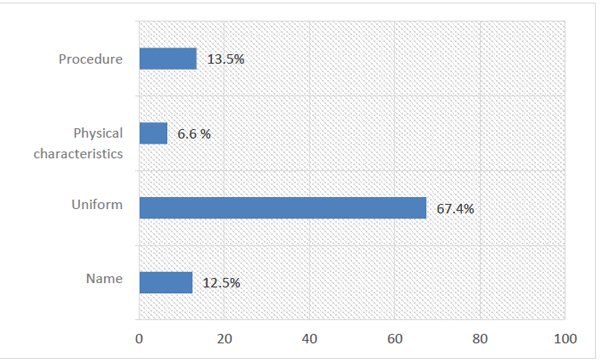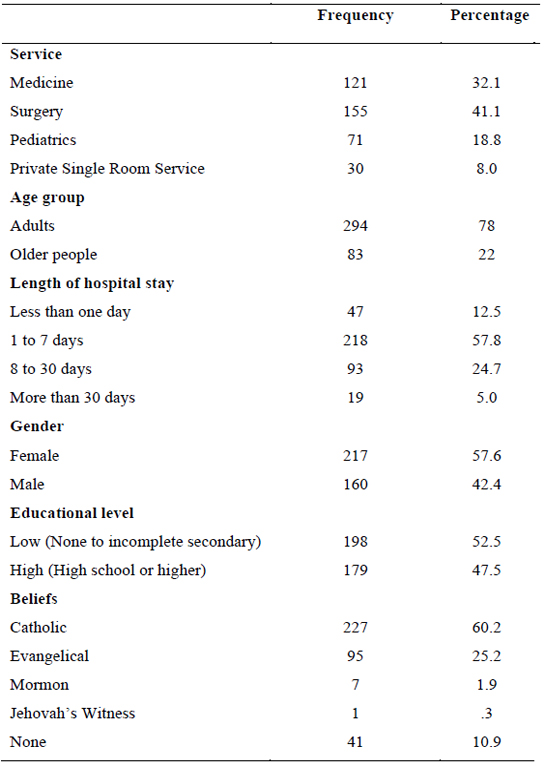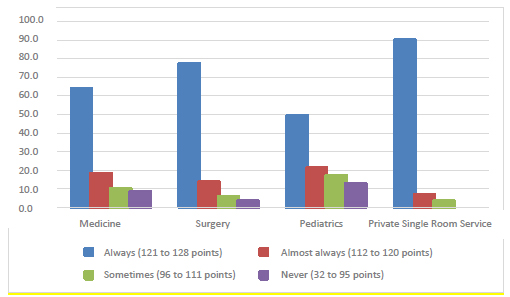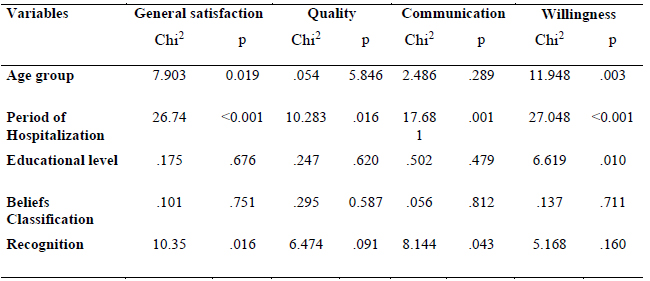Servicios Personalizados
Revista
Articulo
Links relacionados
Compartir
Enfermería: Cuidados Humanizados
versión impresa ISSN 1688-8375versión On-line ISSN 2393-6606
Enfermería (Montevideo) vol.11 no.1 Montevideo jun. 2022 Epub 01-Jun-2022
https://doi.org/10.22235/ech.v11i1.2635
Original Articles
Perception of Hospitalized Patients Regarding Nursing Care
1 Universidad De Los Lagos, Chile, carlosalberto.fernandez@ulagos.cl
2 Universidad De Los Lagos, Chile
3 Universidad De Los Lagos, Chile
4 Universidad De Los Lagos, Chile
5 Hospital Puerto Montt, Chile
Introduction:
Humanized care requires the interaction between scientific knowledge and values, generating the need to particularize care, which is an essential activity in nursing.
Objective:
To analyze the perception of hospitalized users regarding the humanized care they receive from nursing professionals.
Methodology:
A quantitative, descriptive, correlational, and cross-sectional research was carried out, which included hospitalized users in the Clinical Services of Medicine, Surgery, Private, and legal representatives of patients under 18 years of age in Pediatrics, of a public hospital located in the south of Chile, with a sample of 377 participants. After the application of informed consent, it was applied a sociodemographic characterization as well as the instrument Perception of Humanized Nursing Care Behaviors - Version 3, with transcultural adaptation for the Chilean population, which was complemented with other data pertinent to the objectives of the research.
Results:
It was found that most of the participants recognized the nursing professional by the uniform, and despite some differences in each service, they reported satisfaction with the care received (84.6%). Aspects such as age, length of hospitalization and recognition of the nursing staff showed a statistical relation with satisfaction.
Conclusions:
It is necessary to implement strategies to strengthen the perception of humanized nursing care, being these aspects a contribution to the construction of an organizational climate and culture that evidences this perspective of care.
Keywords: humanization of assistance; nursing care; nursing; nurse clinicians; quality of health care
Introducción:
La atención humanizada requiere la interacción entre los conocimientos científicos y los valores, generando la necesidad de particularizar los cuidados, siendo esta una actividad esencial en enfermería.
Objetivo:
Analizar la percepción que tienen los usuarios hospitalizados respecto del cuidado humanizado que reciben por parte de las profesionales de enfermería.
Metodología:
Se desarrolló una investigación de tipo cuantitativa, descriptiva, correlacional y de corte transversal, que incluyó a los usuarios hospitalizados en los Servicios Clínicos de Medicina, Cirugía, Pensionado y representantes legales de pacientes menores de 18 años en Pediatría, de un hospital público ubicado en el sur de Chile, con una muestra de 377 participantes. Posterior a aplicación de consentimiento informado, se aplicó una caracterización sociodemográfica y el instrumento Percepción de Comportamientos de Cuidado Humanizado de Enfermería - versión 3, con adaptación transcultural para la población chilena, el cual fue complementado con otros datos pertinentes a los objetivos de la investigación.
Resultados:
Se encontró que las personas participantes en su mayoría reconocieron al profesional de enfermería por el uniforme, y pese a existir algunas diferencias en cada servicio, refirieron satisfacción con el cuidado recibido (84,6 %). Aspectos como la edad, el tiempo de hospitalización y el reconocimiento del personal de enfermería, evidenciaron relación estadística con la satisfacción.
Conclusiones:
Se requiere implementar estrategias para fortalecer la percepción del cuidado humanizado de enfermería, siendo estos aspectos una contribución para la construcción de un clima y cultura organizacional que evidencien esta perspectiva de cuidado.
Palabras clave: humanización de la atención; atención de enfermería; enfermería; enfermeras clínicas; calidad de la atención de salud
Introdução:
Uma atenção humanizada requer a interação entre saberes científicos e valores, gerando a necessidade de particularização ou cuidado, sendo essa uma atividade essencial na enfermagem.
Objetivo:
Analisar a percepção que os usuários hospitalizados têm sobre o atendimento humanizado que recebem dos profissionais de enfermagem.
Método:
Es uma investigação quantitativa, descritiva, correlacional e transversal, que incluiu os usuários hospitalizados nos Serviços de Medicina, Cirurgia, Pensionista e representantes legais de pacientes menores de 18 anos em Pediatria, de um hospital público localizado no sul do Chile, com uma amostra de 377 participantes, Após a aplicação do consentimento informado, foi aplicada uma caracterização sociodemográfica e foi aplicado o instrumento Percepção de Comportamentos de Assistência Humanizada de Enfermagem - versão 3, com adaptação transcultural para a população chilena, ou que foi complementado com outros dados pertinentes aos objetivos da pesquisa.
Resultados:
Verificou-se que os participantes, em sua maioria, reconheciam ou profissionais de enfermagem pelo uniforme e, apesar da existência de algumas diferenças em cada Serviço, relatam sentir-se satisfeitos com o atendimento recebido (84,6 %). Aspectos como a idade, tempo de internação e reconhecimento da equipe de enfermagem apresentam relação estatística com a satisfação.
Conclusões:
É necessário implementar estratégias que fortaleçam a percepção do cuidado humanizado de enfermagem, sendo esses aspectos uma contribuição para a construção de um clima e cultura organizacional que demonstrem essa perspectiva de cuidado.
Palavras-chave: humanização da assistência; cuidados de enfermagem; enfermagem; enfermeiras clínicas; qualidade da assistência à saúde
Introduction
Humanized care could be defined as interaction between scientific knowledge and human values to establish quality care centered on the individual. 1 In nursing it is:
The act of caring towards a person, family and community by acknowledging the other as equal to me, in terms of their dignity as a human being, thinking about their health and care needs and their responses to those needs, providing assistance by respecting ethical imperatives in those needs in which they are deficient, and promoting, within the possibilities, early recovery of their self-care. 2
This requires nursing staff to adopt a practical and moral behavior.3) Based on the above definition, personalized care of users is at the heart of the nursing profession, in Jean Watson’s theory of Human Care, all human action that contributes to the help and concern for the needs of others is caring activity. In a study by Hermosilla et al., 4 the focus of humanized care is personal experience of the illness and how it helps to understand and live this process, through emotional expression. However, there are situations such as extensive organizational restructuring and new technologies which influence nursing professionals’ work, in some cases forgetting its essence, which is respect for life and human beings’ professional care. 5,6
Different studies have shown how important humanized nursing care can be as determinant factor during recovery, both for the user and his or her family. 7) It is worth mentioning that, as individuals, they are vulnerable, and hospitalization process breaks down people’s internal order, resulting in increased emotional, physical, and psychological vulnerability. By this logic, a sick person is vulnerable and dependent on care. Hospitalized patients often suffer from anxiety as they perceive a hostile hospital environment making it difficult for them to cope with their illness. 8
Among research conducted on this subject, we can mention a study published in Madrid in 2019 by López and Villaverde, which mentions that hospitals are a setting in which physical and psychological sufferings are constantly present.9 In the same year, 2019, Alfaro and Atria published a study developed in the infant population, in which it was revealed that 50 % of the children analyzed experienced emotional alteration during hospitalization, revealing a significant association between a bad hospital environment and its negative influence on their emotional state. 10
These studies have shown that research into hospitalized users’ perceptions is a complex process, which depends on characteristics such as culture, expectations, personal factors, as well as previous experiences and disease itself. 11 For this reason, it was considered necessary to include demographic characteristics of users and their perception toward nursing professionals.
In Latin America, it is possible to mention the following findings: at one hospital in Ecuador, a good perception of humanized care was obtained, with 65 % prioritizing care category, 56.3 % regarding openness to communication to provide health education to the person and 59.4 % regarding nursing qualities.12 In Mexico, Puch-Ku et al. 13) also highlighted a predominance in favorable perceptions of humanized care; some similar findings were reported in Colombia in 2015,14) where users' satisfaction and experiences about nursing care are above 70 %. In Chile in 2018, research was also conducted with hospitalized users, where 86 % considered that they had always received humane treatment, highlighting 0.6 % who never perceived humane treatment, as well as “qualities of doing”, i.e., users perceived that nursing staff are able to identify their needs, maintain cordial treatment, are readily available when required and educate them. 15
In contrast to previous evidence, there are two studies reported in Peru with less favorable results regarding humanization perception. The first one, conducted in Lima by Guerrero Ramirez et al, found that 52 % of the nurses’ human care is regular. 16 The second one, conducted in another hospital in Peru, found that just 36 % of the users surveyed said they had always perceived humanized care. 17
In accordance as mentioned above, evidence suggests it is important to know how users perceive humanized nursing care in hospital environments, because this has an impact on users’ well-being, as well as on their care processes such as discharge, satisfaction during their stay, and other aspects related to care quality.
The general objective of this research was to analyze the perception that hospitalized users have in relation to the humanized care they receive from nursing professionals. The specific objectives were to establish a profile of those users who do not identify nursing professionals, and those characteristics by which they do identify them; establish their sociodemographic profile and their perceptions of the humanized care received by nursing professionals; and, finally, to relate care perception taking into consideration sociodemographic variables and each clinical service.
Methodology
A quantitative, descriptive, correlational, and cross-sectional (18 research study has been developed between April and August 2019.
Target population were hospitalized patients in clinical services: Medicine, Surgery, Private Single Room service and legal representatives of patients under 18 years old at Pediatric service of a public hospital located in the south of Chile. Inclusion criteria were as follows: hospitalized patient or legal representative over 18 years old, admitted and categorized in the hospital's computerized register, with no alteration in their state of consciousness, who were not in discharge process or with any other condition that could affect their participation, as well as patients who identified nursing professionals who had provided care during their stay. Patients under sedation, patients with language disorders or with a diagnosis of any psychiatric pathology were excluded.
Netquest sample calculator has been used to estimate this sample. In addition, total annual discharges were taken as universe, which consisted of 14,612 users; to calculate this sample, a 95 % confidence and 5 % error rate were considered, which gave a total of 375 users; however, 377 surveys were collected in the process, those that were used in the final analysis. To comply fully with first objective, data from 49 people who did not identify nursing professionals was analyzed, which is why 426 people were contacted throughout the entire research process.
This research was submitted to Hospital Management and Care Management Department, with their authorization, a group of final year nursing students and professionals were trained and supported during data collection. An informed consent process involving the participants was applied, where it was explained beforehand, among other things, their willingness to participate in the process, where their services would not be affected for any reason, and that information would be treated anonymously, guaranteeing data confidentiality; subsequently, the research instruments were applied to them.
Perception was considered as a dependent variable, and socio-demographic characteristics and clinical service as independent variables. The instrument used starts with general data such as clinical service, date and time of hospitalization, and then socio-demographic data such as age, sex, educational level, and beliefs. A question about whether or not the user identified nursing professionals was added; if they answered “No”, its application was suspended, and if they answered “Yes”, options were given to find out in what way they identified them.
Then, questions were applied using the instrument Perception of Humanized Nursing Care Behavior version 3 (PHCE3), with cross-cultural adaptation to the Chilean population. 19 This instrument has a Cronbach’s alpha of 0.92 and contains 32 items with a Likert scale in a four-option format: always, almost always, sometimes and never. These questions refer to three dimensions: nursing qualities (quality), openness to nurse/patient communication (communication), and willingness to provide care (willingness). To establish global satisfaction, scores were interpreted as follows: always (128-121 points), almost always (120 to 112 points), sometimes (111 to 96 points), never (95 to 32 points). Scores of always and almost always were interpreted as indicating user satisfaction, while scores of sometimes and never were interpreted as dissatisfaction.
The information obtained was analyzed using SPSS software version 17, applied Chi2 tests, considering significant associations with p values ≤ 0.05.
This study received positive approval from Scientific Ethical Committee of Reloncaví Health Service (Ordinary 28-2019), which guaranteed respect for the legislation and regulations in force in terms of research with human beings.
Results
From all respondents, 88.5 % were able to recognize which nursing professional was providing their care. When asked how this recognition was made, 67.4 % of respondents reported it was because of their uniform (Graphic 1).
With regard the remaining 11.5 % (49 people), who said they could not identify them, it was possible to establish their profile, which consisted in adults between 18 and 64 years (51 %), mostly men (57.1 %); with a high education level (71.4 %), and less than 7 days of hospitalization (67 %).
Regarding user profile of those whose perception of humanized care was assessed, it was found that most were from Medicine and Surgery clinical services (73.2 %), adults between 18 and 64 years (mean 48.63, SD 17.63), women, with low educational level, hospital stay between 1 and 30 days (82.5 %), and whose beliefs were predominantly catholic and evangelical. It should be noted that low educational level consisted of incomplete secondary or high school education. Table 1
When asked about humanized nursing care perception, most users reported feeling satisfied by 84.6 % (always: 68.7% and almost always: 15.9%, minimum value 42, maximum 128, mean 119.64, SD: 12.89). Regarding always criteria, patients in Private Single Room Service received 90 %, while Pediatrics clinical service achieved 49.3 %, despite the fact that this service reached satisfactory criteria together with almost always criteria (70.4 %). In Medicine and Surgery clinical services, satisfaction was 81.8 % and 90.9 % respectively (Graph 2). It is worth mentioning that perception according to Clinical Service was significant: Chi2: 29.08; p=0.001.
When analyzing satisfaction according to instrument dimensions, it could be seen that Quality was the best perceived in relation to evaluated services (90 %), followed by Willingness (85 %), and Communication (84 %).
Analysis by service and dimension established that Quality and Disposition obtained a satisfaction rate of 100 % in Private Single Room Clinic Service, while Communication obtained a satisfaction rate of 94 % in Surgery Clinic Service. Despite each dimension showing satisfaction in Pediatrics Clinical Service, dissatisfaction was higher when compared to the other Clinical Services (Table 2).
Table 2: Perception of humanized care according to dimension and clinical service
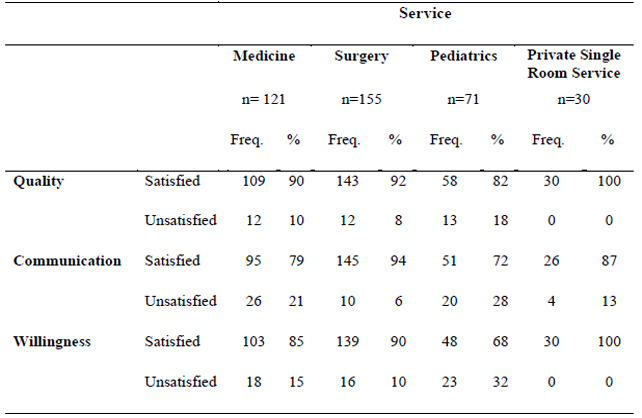
Source: Own elaboration (2021)
It is noteworthy that statement number 1 of this instrument corresponding to quality dimension (He/she has been treated as a person) obtained the best general rating, 92 % of the criteria always; concerning willingness dimension, statement 25 of the instrument: (he/she has been asked and cared about his/her state of mind) in Pediatrics obtained 32.4 % of dissatisfaction (never: 23.9 %, almost never: 8.5 %).
Despite lacking statistical significance there are several statements in the instrument from which a satisfactory perception would be expected, but the existence of dissatisfaction in percentages of around 1 % allows us to interpret that humanized care behaviors towards users were omitted.
Correlational analysis of users’ perception of humanized care according to their profile revealed associations between satisfaction and age (Chi2: 7.90; p=0.019), hospitalization length (Chi2: 26.74; p= <0.001) and nursing professional acknowledgement (Chi2: 10.35; p=0.016). According to this, it could assert that users’ perception of satisfaction increases with age, especially on willingness dimension (Chi2: 11.94; p=0.003). On the other hand, as length of stay increased, users had a higher satisfaction perception, hence a higher perception of humanized care in all three evaluated aspects. There was evidence that if there are more recognition of the nursing professional, satisfaction will improve, particularly in Communication dimension (Chi2: 8.14; p=0.043). Educational level showed an association with willingness dimension (Chi2: 6.61; p= 0.010) (Table 3).
Discussion
As reviewed, there are several issues to be considered in this study, including how users identify who provides care, how they feel about receiving nursing care and how well they feel being cared for, which eventually has an impact on their perception of the humanization of care.
Although it is described in the results that nursing professionals who provide care are generally recognized mainly by their uniforms (in Chile, nurses usually wear navy blue, nursing technicians wear light blue and assistants wear grey or white), there are repeated modifications and inappropriate use of uniforms within the institutions, 20 which means that users often do not recognize either their status or the role played by health officials, which may alter their perception of personalized and humanized care.
This may be due to several reasons: according to the literature, there are many young people joining, a lack of proper orientation or they are not required to comply with institutional rules, as well as, many times, these changes may respond to new trends in dress and fashion within the clinical environment.20 This is remarkable since one would think that badges and verbal identification would be the primary method of recognition.
In the same sense, it is necessary to recognize nursing professionals as a positive factor in the perception of humanized care, in which communication is the most influential aspect, leading to the consideration of actions that tend to strengthen listening, understanding, accompanying, and clarifying skills as part of the nursing process, and it is important to leave a written record of these activities, to promote continuity of care and demonstrate its quality. Given this context, it is pertinent to implement training on this issue, which should intentionally include new staff joining the institution.
On the other hand, it should be borne in mind that an emphasis on biomedical aspects, leaving aside biopsychosocial and spiritual approaches, can lead to dehumanized care,21 so it is recommended to provide personalized care to the needs of each user, considering aspects such as compassionate, humane, and respectful service, as well as research into attitudes, perceptions and knowledge about spirituality and death by nursing staff in the future.
In relation to humanized care dimensions in the Clinical Services analyzed, according to the findings, there is a general positive perception of user satisfaction, being significant those results obtained in Private single room Service, so it is important to investigate this phenomenon in future research.
So, in contrast to Monje et al. 2018 15 findings, which mention that there are no differences between age groups and humanized care perception, this study found a statistical association between the variables, which invites us to maintain the care given to older people, but we must work intentionally to improve the perception of other younger age groups.
There was another finding related to hospitalization time as a factor that facilitates perception of humanized care behaviors. This could be related to bonds built in all areas through constant interaction between people, encouraging trust and security for nurses, two fundamental aspects that contribute to the well-being of the people under their care, and which also have an impact on their environment, in line with their professional sense.22,23
On the other hand, the perception of humanized care in pediatric services involves a wider scope than in adult care, by involving children and their companions/families, which links aspects such as attention, concern, and often affective participation with patients, creating a triad of care between nurse, children, and their relatives or companions. 24
It is worth to mention that escort /family members’ perception is associated with strategies such as comprehensive listening, verbal and non-verbal communication, optimization of information between team members as well as between team members towards the child and his/her family member or companion, highlighting honesty as a key factor when providing information. 24
If it is compared how humanized care is perceived in pediatric facilities with other types of facilities where adults are treated, it is possible to appreciate differences regarding bonds engendered. Hospitalization causes ambivalent feelings and emotions, mainly negative feelings, parental role is compromised by hospitalization, parents feel powerless against their sons’ and daughters’ needs, reflecting global and individualized care demand and where nurses adopt a collaborative care model. 25 It is important that nurses have the skills to recognize these parents as vulnerable, providing reassurance, care, and attention to their needs.
The study results recognize how challenging it is to see humanization as one of the priorities in nursing work, even though many times biomedical care is chosen as a priority. The nursing profession must contemplate human beings in their biopsychosocial and family factors, to provide comprehensive care for people and promote their recovery. There is a need to promote research and training in this type of subject matter, and to recognize the aspects of humanized treatment as a fundamental part of care, and to consider them as part of the lost care that generates or promotes alterations in people's well-being. 26
Conclusions
These results allow us to suggest to health institutions how to incorporate aspects related to humanization as part of their training. In addition, successful care experiences that are being generated in some of the clinical areas can be identified and replicated, which could lead to protocols that guide care provision from a humanized perspective. In this way, it would be aiding in the construction of an organizational climate and culture that would evidence such a perspective, in aspects such as: greeting, staff identification, nursing professionals’ presence during family visits, among other strategies that may be considered relevant to institutional particularities, taking Jean Watson’s model as a reference in care model. 27
It is also an invitation to all nursing professionals to constantly reflect on their professional practice, and how they intentionally incorporate into its behaviors that lead to demonstrate a humanized attitude. 28
It is recognized that quantitative design has limitations, which is why it is considered pertinent to develop qualitative research that allows in-depth study of care phenomena related to humanization perceptions in both users and nursing professionals.
It is worth highlighting that this study has been developed before COVID-19 pandemic, which is why it would be opportune to develop research related to care, humanization of care, and particularly communication regarding personal protective equipment, to demonstrate skills built up by nursing professionals who had to overcome these difficulties.
REFERENCES
1. Llanes, G, Bejarano, D, Márquez, L, Ponce, C, Martinez, R. La humanización de la atención de enfermería en salud laboral. Revista Enfermería del Trabajo. 2018;8(1):18-26. [ Links ]
2. Espinosa, Á, Enríquez, C, Leiva, F, López, M, Castañeda, L. Construcción colectiva de un concepto de cuidado humanizado en enfermería. Cienc. Enferm. 2015;21(2):39-49 DOI: 10.4067/S0717-95532015000200005 [ Links ]
3. Mora, L. Los principios éticos y bioéticos aplicados a la calidad de la atención en enfermería. Rev Cubana Oftalmol. 2015;28(2),228-233. [ Links ]
4. Hermosilla, A, Mendoza, R, Contreras, S. Instrumento para valoración del cuidado humanizado brindado por profesionales de enfermería a personas hospitalizadas. Index Enferm. 2016;25(4):273-277. [ Links ]
5. Escobar-Castellanos, B, Cid-Henríquez, B. El cuidado de enfermería y la ética derivados del avance tecnológico en salud. Acta Bioethica. 2018;24(1):39-46. DOI: 10.4067/S1726-569X2018000100039 [ Links ]
6. Arandojo, M. Nuevas Tecnologías y nuevos retos para el profesional de enfermería, Index Enferm. 2016;25(1-2):38-41. [ Links ]
7. Díaz-Rodríguez, M, Alcántara, L, Aguilar, D, Puertas, E, Cano, M. Orientaciones formativas para un cuidado humanizado en enfermería: una revisión integrativa de la literatura, Enfermería Global (Internet). 2020;19(2):640-672. DOI: 10.6018/eglobal.392321 [ Links ]
8. Izquierdo, E. Enfermería: Teoría de Jean Watson y la inteligencia emocional, una visión humana. Rev Cubana de Enfermer. 2015;31(3). [ Links ]
9. López, A, Villaverde, O. Intervención psicológica en el ámbito hospitalario. Número monográfico: psicología y salud. Rev. Clín Contemp. 2019;10(1):1-19. DOI: 0.5093/cc2019a2 [ Links ]
10. Alfaro, A, Atria, R. Factores ambientales y su incidencia en la experiencia emocional del niño Hospitalizado (2º parte). Rev. Ped. Elec. 2019;6(1). [ Links ]
11. Silva-Fhon, J, Ramón-Cordova, S, Vergaray-Villanueva, S, Palacios-Fhon, V, Partezani-Rodrigues, R. Percepción del paciente hospitalizado respecto a la atención de enfermería en un hospital público. Enferm. Univ. 2015;12(2). DOI: 10.1016/j.reu.2015.04.001 [ Links ]
12. Chamba Guamo, B. Cuidado humanizado de Enfermería en pacientes ingresados en el área de Cirugía del Hospital Militar 7BI de la ciudad de Loja desde Diciembre 2019- Febrero 2020. Rev. Ocronos. 2020;3(2):114. [ Links ]
13. Puch-Ku, GF, Uicab-Pool, GÁ, Ruiz-Rodríguez, M, Castañeda-Hidalgo, H. Dimensiones del cuidado de enfermería y la satisfacción del paciente adulto hospitalizado. Rev Enferm IMSS. 2016;24(2):129-136. [ Links ]
14. Lenis-Victoria, C, Manrique-Abril, F. Calidad del cuidado de enfermería percibida por pacientes hospitalizados. Aquichan. 2015;15(3):415-25. DOI: 10.5294/aqui.2015.15.3.9 [ Links ]
15. Monje, P, Miranda, P, Oyarzün, J, Seguel, F, Flores, E. Percepción de cuidado humanizado de enfermería desde la perspectiva de usuarios hospitalizados, Cienc. enferm. 2018;24(1):5. DOI: 10.4067/s0717-95532018000100205 [ Links ]
16. Guerrero-Ramírez, R, Meneses-La Riva, M, De La Cruz-Ruiz, M. Cuidado humanizado de enfermería según la teoría de Jean Watson, servicio de medicina del Hospital Daniel Alcides Carrión. Lima-Callao, 2015. Rev enferm Herediana. 2016;9(2):133-142. [ Links ]
17. Gutiérrez Vásquez, D, Percepción de comportamientos de cuidado humanizado de enfermería en pacientes adultos hospitalizados en servicios de medicina. Chiclayo. 2018. Rev. acc cietna: para el cuidado de la salud. 2019;6(2):68-82. DOI: 10.35383/cietna.v6i2.258 [ Links ]
18. León, OG, Montero, I. Métodos de investigación en Psicología y Educación. Madrid: McGraw-Hill;2012. [ Links ]
19. Melita, A, Jara, P, Pereira, D, Luengo, L. Adaptación transcultural y validación de un cuestionario de cuidado humanizado en enfermería para una muestra de población Chilena. Rev Cuid. 2018;9(2):2245-56. DOI: 10.15649/cuidarte.v9i2.531 [ Links ]
20. León, C. El uniforme y su influencia en la imagen social. Rev Cubana Enfermer. 2006;22(1). [ Links ]
21. González-Juárez, L, Velandia-Mora, A, Flores-Fernández, V. Humanización del cuidado de enfermería. De la formación a la práctica clínica. Rev CONAMED. 2009;14(1):40-43. [ Links ]
22. Hidalgo-Mares, B, Altamira-Camacho, R. ¿Qué es y qué no es el cuidado de enfermería?. Revista Enfermería Actual. 2020.(40). DOI: 10.15517/revenf.v0i39.40788 [ Links ]
23. Racionero, S. Relaciones humanas de calidad como contexto de salud y libertad. Revista de Fomento Social. 2018;(289):43-63. DOI: 10.32418/rfs.2018.289.1434 [ Links ]
24. Villa, L, Silva, J, Silva, J, Costa, F, Camargo, C. A percepção do acompanhante sobre o atendimento humanizado em unidade de terapia intensiva pediátrica. Rev. pesqui. cuid. Fundam. 2017;9(1):187-192. [ Links ]
25. Vieira, N, Batoca, E. Vivência dos pais durante a hospitalização do recém-nascido prematuro. Rev. Enf. Ref. 2015;4(4):107-115. DOI: 10.12707/RIV14032 [ Links ]
26. Hernández Cruz, R, Moreno Monsiváis, MG, Cheverría Rivera, S, Landeros López, M, Interial Guzmán, MG. Cuidado de enfermería perdido en pacientes hospitalizados en una institución pública y una privada. Index Enferm. 2017;26(3):142-146. [ Links ]
27. Tercero Gualpa, CA. Modelo de cuidado humano y su aplicación a pacientes con covid-19: Ecuador 2020. Ocronos. 2021;4(3):80. [ Links ]
28. Prias, H. Cuidado humanizado: un desafío para el profesional de enfermería. REVISALUD Unisucre. 2017;3(1) [ Links ]
How to cite: Fernández-Silva CA, Mansilla-Cordeiro EJ, Aravena Flores A, Antiñirre Mansilla B, Garcés Saavedra MI. Perception of Hospitalized Patients Regarding Nursing Care. Enfermería: Cuidados Humanizados. 2022;11(1), e2635. DOI: 10.22235/ech.v11i1.2635
Contribution of the authors: a) Study conception and design, b) Data acquisition, c) Data analysis and interpretation, d) Writing of the manuscript, e) Critical review of the manuscript. C. A. F. S. has contributed in a, b, c, d, e; E. J. M. C. in a, c, d, e; A. A. F. in a, b, d, e; B. A. M. in a, b, d, e; M. I. G. S. in b, d, e.
Received: July 21, 2021; Accepted: February 14, 2022











 texto en
texto en 


